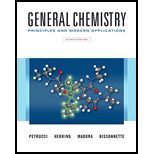
(a)
Interpretation:
The difference between a strong electrolyte and a strong acid needs to be explained.
Concept introduction:
A strong acid is a compound or solute completely dissociates or ionizes in solution to give proton. The concentration of proton increases instantly by addition of acid in solution.
Strong electrolyte involves the compounds such as NaCl, KCl which dissociates completely to give the corresponding ions present in it.
Due to the 100 % dissociation, they are known as good conductor of electricity. Strong acids, strong bases and ionic compounds are good example of strong electrolyte.
(b)
Interpretation:
The difference between oxidizing agent and reducing agent needs to be explained.
Concept introduction:
A
A reactant that loses electron/s gets positive charge on it and undergoes oxidation. While reactant that accepts electron/s gets negative charge on it and undergo reduction.
The reactant or species getting reduced in the reaction by accepting the electron helps in the oxidation of other reactant and thus act as oxidizing agent.
The reactant or species getting oxidized in the reaction by releasing the electron helps in the reduction of the other reactant and thus act as reducing agent.
(c)
Interpretation:
The difference between precipitation reaction and neutralization reaction needs to be explained.
Concept introduction:
Neutralization reactions generally involve the
Precipitation reaction generally involves the precipitation of the reactants present in the reaction. Formation of precipitates takes place on the reaction between the electrolytes in the reaction.
(d)
Interpretation:
The difference between half reaction and overall reaction needs to be explained.
Concept introduction:
A redox reaction is the reaction consists of reactant in which one reactant gets oxidized and other gets reduced.
A reactant that loses electron/s gets positive charge on it and undergoes oxidation. While reactant that accepts electron/s gets negative charge on it, undergo reduction.
Want to see the full answer?
Check out a sample textbook solution
Chapter 5 Solutions
General Chemistry: Principles and Modern Applications (11th Edition)
- what is the drawn mechanism for diethyl carbonate and 4 - bromo - N, N -dimethylaniline to create crystal violet?arrow_forwardWhich of the following compounds are constitutional isomers of each other? I and II O II and III O III and IV OI and IV O II and IV CI H CI H CI H H CI H-C-C-CI C-C-C-CI H-C-C-CI H-C-C-CI H CI Ĥ ĆI A A Ĥ ĆI || IVarrow_forwardPlease correct answer and don't used hand raitingarrow_forward
- Q1: Curved Arrows, Bronsted Acids & Bases, Lewis Acids & Bases Considering the following reactions: a) Predict the products to complete the reactions. b) Use curved electron-pushing arrows to show the mechanism for the reaction in the forward direction. Redraw some of the compounds to explicitly illustrate all bonds that are broken and all bonds that are formed. c) Label Bronsted acids and bases in the left side of the reactions. Label conjugate acids and bases in the right side of the reactions. d) Label Lewis acids and bases, nucleophiles and electrophiles in the left side of the reactions. A. + OH CH30: OH B. + HBr C. H₂SO4 D. CF 3. CH 3 + HCI N H fluoxetine antidepressant 1↓ JDownloadarrow_forwardDon't used Ai solutionarrow_forwardPart 3: AHm,system Mass of 1.00 M HCI Vol. of 1.00 M HCI Mass of NaOH(s) Total Mass in Calorimeter Mole product if HCI limiting reactant Trial 1 62.4009 1.511g Mole product if NaOH limiting reactant Limiting reactant Initial Temperature Final Temperature 23.8°C 37.6°C Change in Temperature AHm,system (calculated) Average AHm,system (calculated) (calculated) (calculated) Trial 2 64.006g 1.9599 (calculated) (calculated) (calculated) (calculated) (calculated) (calculated) 24.7°C 41.9°C (calculated) (calculated) (2 pts. each)arrow_forward
- 1.) Using the graph below (including the line equation of y = -1.823x - 0.0162) What is the numerical value for the slope shown? 2.) What are the Unit(s) associated with the slope of the line shown? for we all remember that numerical data always has units. 3.) What would be a good title for this graph and explain your choice. 0.00 0.0 02 0.4 10.6 08 10 12 -0.20 -0.40 -0.60 -0.80 Temp, freezing, in degrees Celcius 5-1.00 -1.20 -1.40 -1:60 y=-1.823x-0.0162 -180 -2.00 Concentration of Sucrose (m)arrow_forwardDon't used Ai solutionarrow_forwardIdentify the Functional Groups (FG) in the following molecules. Classify C atoms as tertiary, 30, or quaternary 40. Identify secondary 20 and tertiary, 30 hydrogen atoms. Please provide steps to undertand each labeling. Please label in the image, so it fits explanation. I am still very unsure I undertand this.arrow_forward
 Principles of Modern ChemistryChemistryISBN:9781305079113Author:David W. Oxtoby, H. Pat Gillis, Laurie J. ButlerPublisher:Cengage Learning
Principles of Modern ChemistryChemistryISBN:9781305079113Author:David W. Oxtoby, H. Pat Gillis, Laurie J. ButlerPublisher:Cengage Learning Introduction to General, Organic and BiochemistryChemistryISBN:9781285869759Author:Frederick A. Bettelheim, William H. Brown, Mary K. Campbell, Shawn O. Farrell, Omar TorresPublisher:Cengage Learning
Introduction to General, Organic and BiochemistryChemistryISBN:9781285869759Author:Frederick A. Bettelheim, William H. Brown, Mary K. Campbell, Shawn O. Farrell, Omar TorresPublisher:Cengage Learning Chemistry: Principles and ReactionsChemistryISBN:9781305079373Author:William L. Masterton, Cecile N. HurleyPublisher:Cengage Learning
Chemistry: Principles and ReactionsChemistryISBN:9781305079373Author:William L. Masterton, Cecile N. HurleyPublisher:Cengage Learning- Chemistry: Matter and ChangeChemistryISBN:9780078746376Author:Dinah Zike, Laurel Dingrando, Nicholas Hainen, Cheryl WistromPublisher:Glencoe/McGraw-Hill School Pub Co
 Chemistry: The Molecular ScienceChemistryISBN:9781285199047Author:John W. Moore, Conrad L. StanitskiPublisher:Cengage Learning
Chemistry: The Molecular ScienceChemistryISBN:9781285199047Author:John W. Moore, Conrad L. StanitskiPublisher:Cengage Learning





